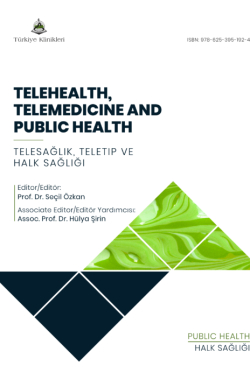Telemedicine Applications and the Case Study of Türkiye
Şuayip BİRİNCİa
aRepublic of Türkiye Ministry of Health, Ankara, Türkiye
Birinci Ş. Telemedicine applications and the case study of Türkiye. In: Özkan S, ed. Telehealth, Telemedicine and Public Health. 1st ed. Ankara: Türkiye Klinikleri; 2024. p.25-30.
ABSTRACT
With technological advances, the healthcare sector is undergoing significant changes and telemedicine practices are gaining more and more importance in this context. Telemedicine, which includes the idea of providing healthcare consultations through electronic communication tools, is pioneering various innovations in the field of healthcare worldwide and especially in Türkiye. In this chapter, under the title ”Telemedicine Practices and the Case of Türkiye”, starting from the definition of telemedicine, it will focus on the rise of telemedicine in the world and in Türkiye, its advantages, the changes it brings and the accompanying challenges. The aim of this chapter is to build an understanding of the developments in the field of telemedicine and the foundation of future healthcare.
Keywords: Telemedicine; delivery of health care; Türkiye
Kaynak Göster
Referanslar
- WHO (World Health Organization). Consolidated telemedicine implementation guide. World Health Organization, 2022.
- OECD (Organisation for Economic Co-operation and Development). Use of teleconsultations. 2024. [Cited: 11.01.2024] Available from: [Link]
- WHO [Internet]. WHO issues consolidated guide to running effective telemedicine services. [Cited: 11 Ocak 2024]. Available from: [Link]
- OECD (Organisation for Economic Co-operation and Development). The COVID-19 Pandemic and the Future of Telemedicine, OECD Health Policy Studies, Editions OECD, Paris, 2023. [Cited: 12.01.2024] Available from: [Crossref]
- Allonneau A, Villeneuve JP, Sempere H, Couderc A, Nicaise A, Soula M, et al. Apport de la téléconsultation et de l'isolement des cas symptomatiques dans la maîtrise de l'épidémie COVID-19 au sein d'une base militaire [The contribution of teleconsultation and isolation of symptomatic cases in control of the COVID-19 outbreak a military base]. Rev Epidemiol Sante Publique. 2021;69(4):167-71. French. [Crossref] [PubMed] [PMC]
- Gajarawala SN, Pelkowski JN. Telehealth Benefits and Barriers. J Nurse Pract. 2021;17(2):218-21. [Crossref] [PubMed] [PMC]
- OECD (Organisation for Economic Co-operation and Development) [Internet]. L'avenir de la télémédecine après le COVID-19. [Cited: 11 January 2024]. Available from: [Link]
- European Commission. Digital Skills. 2023. [Cited: 12 January 2024]. Available from: [Link]
- Drossman DA, Ruddy J. Improving Patient-Provider Relationships to Improve Health Care. Clin Gastroenterol Hepatol. 2020;18(7):1417-26. [Crossref] [PubMed]
- Hwei LRY, Octavius GS. Potential advantages and disadvantages of telemedicine: A literature review from the perspectives of patients, medical personnel, and hospitals. Journal of Community Empowerment for Health. 2021;4(3):228. [Crossref]
- WHO (World Health Organization). Universal health coverage (UHC). 2023. [Cited: 11 January 2024] Available from: [Link]
- BM [Internet]. Santé : 5 milliards de personnes risquent d'être privées de soins en 2030 (OMS). [Cited: 12 January 2024]. Available from: [Link]
- Ekeland AG, Bowes A, Flottorp S. Effectiveness of telemedicine: a systematic review of reviews. Int J Med Inform. 2010;79(11):736-71. [Crossref] [PubMed]
- Angaran DM. Telemedicine and telepharmacy: current status and future implications. Am J Health Syst Pharm. 1999;56(14):1405-26. [Crossref] [PubMed]
- de Oliveira Andrade A, Soares AB, de Andrade Palis A, Cabral AM, Barreto CGL, de Souza DB, et al. On the use of telemedicine in the context of COVID-19: legal aspects and a systematic review of technology. Research on Biomedical Engineering. 2022;38(1): 209-27. [Crossref]
- Schünke LC, Mello B, da Costa CA, Antunes RS, Rigo SJ, Ramos GO, Righi RDR, Scherer JN, Donida B. A rapid review of machine learning approaches for telemedicine in the scope of COVID-19. Artif Intell Med. 2022;129:102312. [Crossref] [PubMed] [PMC]
- Waseh S, Dicker AP. Telemedicine training in undergraduate medical education: mixed-methods review. JMIR medical education. 2019;5(1):e12515. [Crossref] [PubMed] [PMC]
- Barbosa W, Zhou K, Waddell E, Myers T, Dorsey ER. Improving access to care: telemedicine across medical domains. Annual review of public health. 2021;42:463-81. [Crossref] [PubMed]
- OECD (Organisation for Economic Co-operation and Development). State of Health in the EU, Country Health Profiles, OECD Publishing, Paris, 2021, [Cited: 11 January 2024]. Available from: [Crossref]
- American Psychological Association [Internet]. 2022 Covid-19 Practitioner Impact Survey. [Cited: 11 January 2024]. Available from: [Link]
- Strategic Market Research [Internet]. Global Remote Patient Monitoring Statistics 2023 - Facts & Figures. [Cited: 10 January 2024]. Available from: [Link]
- Villarroel MA, Lucas JW. Telemedicine Use in Children Aged 0-17 Years: United States, July-December 2020. Natl Health Stat Report. 2022;(170):1-11. [Crossref]
- Jafarzadeh F, Rahmani F, Azadmehr F, Falaki M, Nazari M. Different applications of telemedicine - assessing the challenges, barriers, and opportunities- a narrative review. J Family Med Prim Care. 2022;11(3):879-86. [Crossref] [PubMed] [PMC]
- Birinci Ş, Ülgü M, Feyzioğlu B, Sebik B, Yarbay Y. Uzaktan Sağlık Hizmetlerinin Sunumu Hakkında Yönetmelik Kapsamında Türkiye'de Sağlık Hizmetleri: Bir Geleneksel Derleme Çalışması. Turkiye Klinikleri Journal of Health Sciences/Türkiye Klinikleri Sağlık Bilimleri Dergisi. 2023;8(3):514. [Crossref]
- Birinci Ş. A Digital Opportunity for Patients to Manage Their Health: Turkey National Personal Health Record System (The e-Nabız). Balkan Medical Journal. 2023;40(3):215. [Crossref] [PubMed] [PMC]

